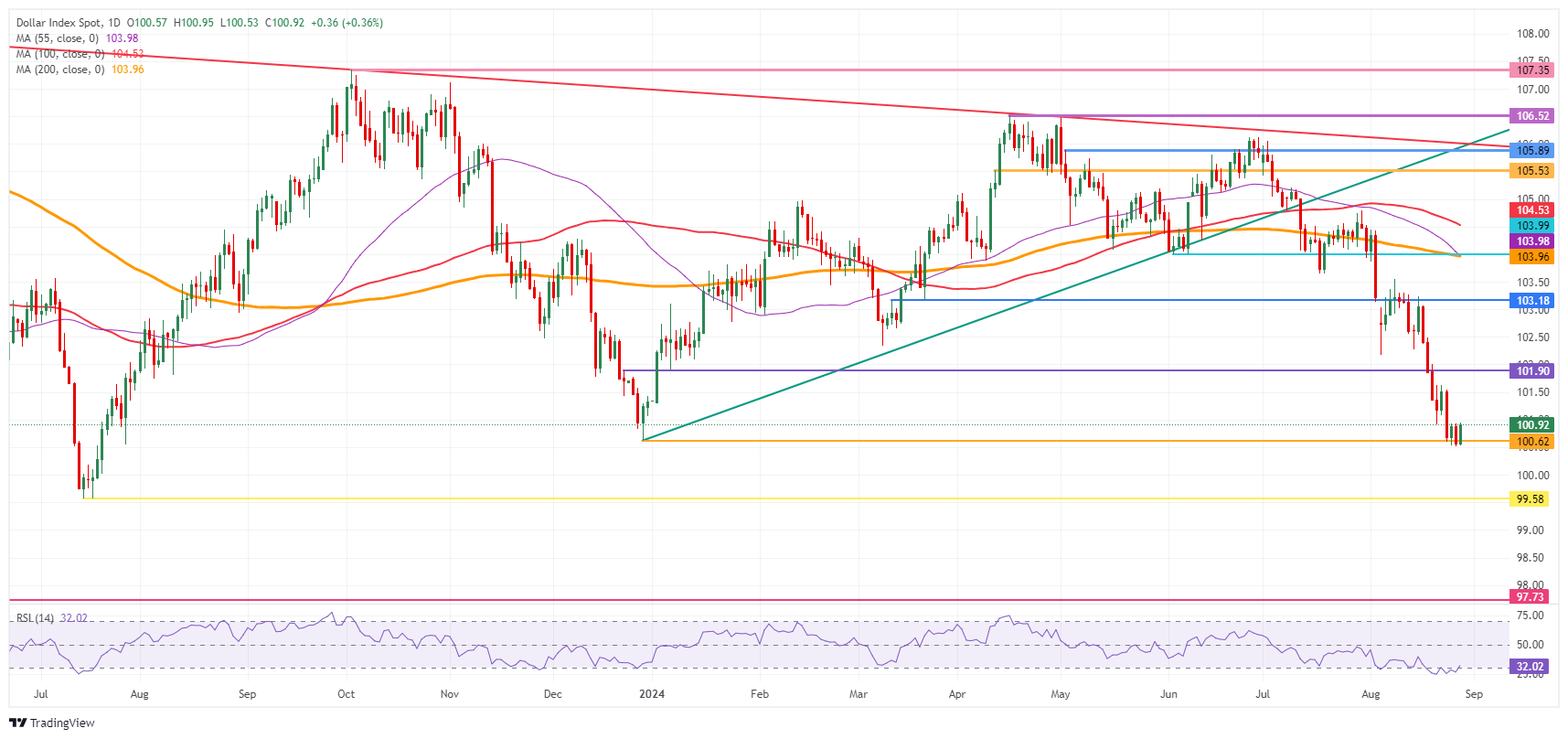- The US dollar is trading flat awaiting a quiet US economic agenda.
- Markets appear to be moving away from risk ahead of Nvidia earnings, which benefits the dollar and weighs on Chinese tech stocks and cryptocurrencies.
- The US Dollar Index is up slightly, trading below 101.00 for the second consecutive day.
The US Dollar (USD) is trading mixed again on Wednesday, with markets somewhat nervous ahead of Nvidia Corp. (NVDA) earnings due after the close of US markets. With some economic figures slowing recently and the Artificial Intelligence (AI) boom softening somewhat, traders are wondering whether Nvidia will be able to maintain its growth momentum and positive earnings streak. If estimates are missed, further risk-off moves could occur, a scenario that would put the US Dollar back in the crosshairs of safe-haven traders.
As for the US economic calendar, there is almost no data to digest on the markets on Wednesday. This adds more tension and expectations for Nvidia earnings. Not even Federal Reserve officials are expected to make an early appearance, as only the president of the Federal Reserve Bank of Atlanta, Raphael Bostic, will speak at 22:00 GMT.
Daily Summary What’s Moving the Market Today: Another Quiet Day
- At 11:00 GMT, the Mortgage Bankers Association released its weekly index of mortgage applications, this time for the week ending August 23. The previous week, the index registered a sharp decline of 10.1% and the most recent figure was 0.5%.
- The US Treasury will auction a 5-year bond at around 17:00 GMT.
- Federal Reserve Bank of Atlanta President Raphael Bostic participates in a moderated Q&A discussion on the U.S. economic outlook at the Stanford Club of Georgia at 22:00 GMT.
- In Asia, stocks were dragged lower by a fall in Chinese technology stocks ahead of Nvidia’s earnings on Wednesday. Both European and US indices are largely flat.
- CME’s Fedwatch tool shows a 63.5% chance of the Fed cutting interest rates by 25 basis points (bps) in September, versus a 36.5% chance of a 50 bps cut. 42.5% expect another 25 bps cut (if a 25 bps cut occurs in September) in November, while there is a 45.4% chance of rates being 75 bps (25 bps + 50 bps) below current levels and a 12.1% chance of rates being 100 bps (25 bps + 75 bps) lower.
- The US 10-year benchmark rate is trading at 3.82%, fairly stable for the second consecutive day.
US Dollar Index Technical Analysis: Nvidia Moving Currencies
The US Dollar Index (DXY) is seeing a very strange factor dictate direction. The hypothesis is quite simple: if Nvidia earnings beat expectations again, a new wave of risk-on flows is likely to push stocks higher and the US Dollar lower. If earnings fall in line with or below expectations, the US Dollar is expected to rally and risk-off flows will send equities south.
To recover, the DXY has a long way to go. First, 101.90 is the level to recover. A strong 2% rise would be needed for the index to reach 103.18 from the current 101.00. A very strong resistance level near 104.00 not only has fundamental technical value, but also has the 200-day simple moving average (SMA) as a second heavyweight to limit price action.
On the downside, 100.62 (the low from December 28) is trying to hold support, although it looks rather weak. If broken, the low from July 14, 2023, at 99.58, will be the last level to watch. Once that level gives way, the first levels of 2023 will be closer to 97.73.
US Dollar Index: Daily Chart
US Dollar FAQs
The United States Dollar (USD) is the official currency of the United States of America, and the de facto currency of a significant number of other countries where it is in circulation alongside local banknotes. As of 2022, it is the most traded currency in the world, accounting for over 88% of all global foreign exchange transactions, equivalent to an average of $6.6 trillion in daily transactions. Following World War II, the USD took over from the British Pound as the world’s reserve currency.
The single most important factor influencing the value of the US dollar is monetary policy, which is determined by the Federal Reserve (Fed). The Fed has two mandates: to achieve price stability (control inflation) and to promote full employment. Its main tool for achieving these two goals is to adjust interest rates. When prices rise too quickly and inflation exceeds the Fed’s 2% target, the Fed raises rates, which helps the dollar. When inflation falls below 2% or the unemployment rate is too high, the Fed can lower interest rates, which weighs on the dollar.
In extreme situations, the Federal Reserve can also print more dollars and enact quantitative easing (QE). QE is the process by which the Fed substantially increases the flow of credit in a jammed financial system. It is an unconventional policy measure used when credit has dried up because banks are not lending to each other (for fear of counterparty default). It is a last resort when simply lowering interest rates is unlikely to achieve the necessary result. It was the Fed’s weapon of choice to combat the credit crunch that occurred during the Great Financial Crisis of 2008. It involves the Fed printing more dollars and using them to buy US government bonds, primarily from financial institutions. QE typically leads to a weakening of the US dollar.
Quantitative tightening (QT) is the reverse process whereby the Federal Reserve stops buying bonds from financial institutions and does not reinvest the principal of maturing securities in new purchases. It is generally positive for the US dollar.
Source: Fx Street
I am Joshua Winder, a senior-level journalist and editor at World Stock Market. I specialize in covering news related to the stock market and economic trends. With more than 8 years of experience in this field, I have become an expert in financial reporting.








